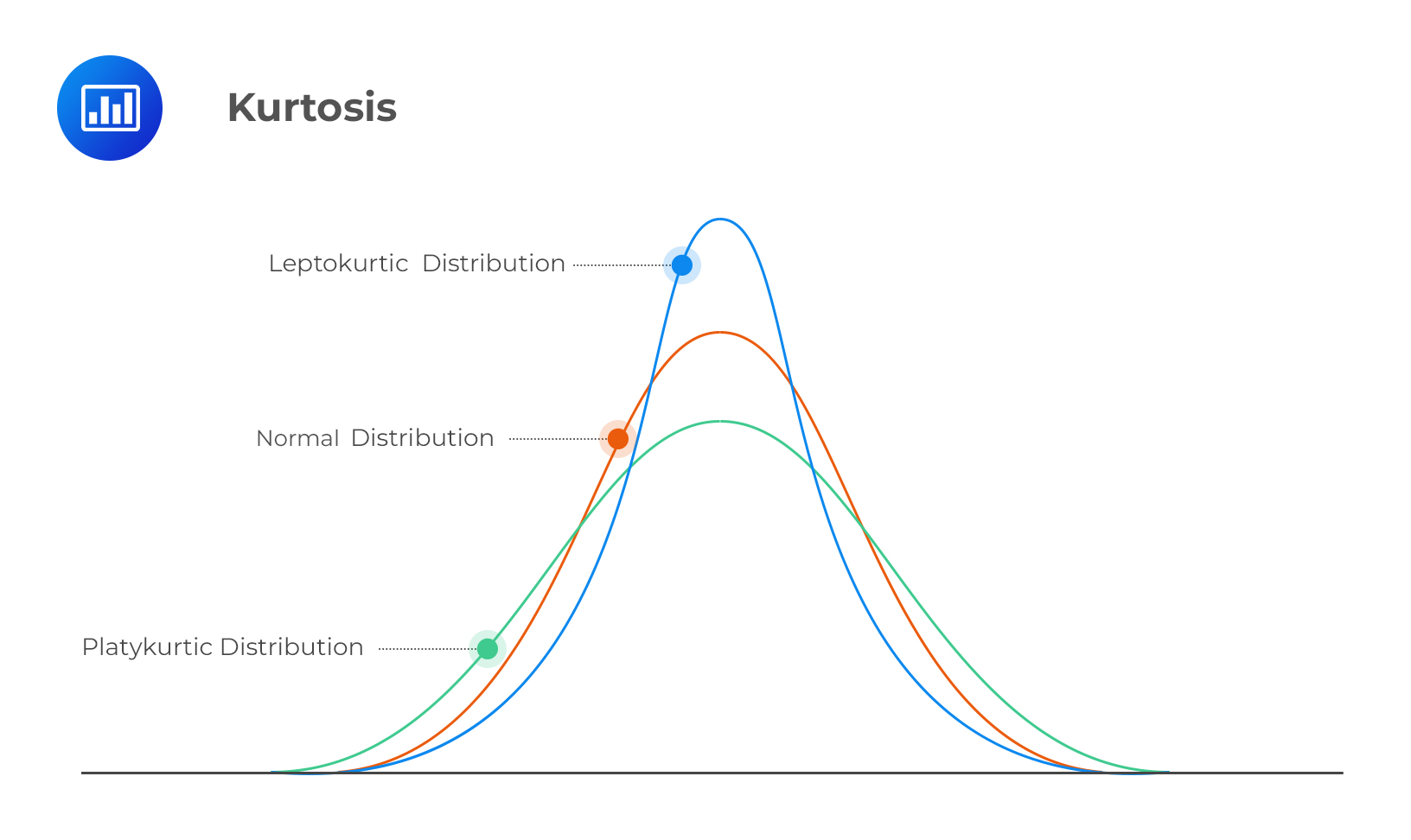Monte Carlo Simulation
Monte Carlo simulations involve the creation of a computer-based model into which variabilities... Read More
[vsw id=”alD9eAT2lQU” source=”youtube” width=”611″ height=”344″ autoplay=”no”]
Kurtosis refers to measuring the degree to which a given distribution is more or less ‘peaked’ relative to the normal distribution. The concept of kurtosis is very useful in decision-making. In this regard, we have 3 categories of distributions:

A leptokurtic distribution is more peaked than the normal distribution. The higher peak results from the clustering of data points along the X-axis. The tails are also fatter than those of a normal distribution. The coefficient of kurtosis is usually found to be more than 3.
The term “laptop” means thin or skinny. When analyzing historical returns, a leptokurtic distribution means that small changes are less frequent since historical values are clustered around the mean. However, there are also large fluctuations represented by the fat tails.
A platykurtic distribution has extremely dispersed points along the X-axis, resulting in a lower peak when compared to the normal distribution. “Platy” means broad. Hence, the prefix fits the distribution’s shape, which is wide and flat. The points are less clustered around the mean compared to the leptokurtic distribution. The coefficient of kurtosis is usually less than 3.
Returns that follow this type of distribution have fewer major fluctuations compared to leptokurtic returns. However, you should note that fluctuations represent the riskiness of an asset. More fluctuations represent more risk and vice versa. Therefore, platykurtic returns are less risky than leptokurtic returns.
Lastly, mesokurtic distributions have a curve that’s similar to that of the normal distribution. In other words, the distribution is largely normal.
Exam tip: The learning outcome statement reads, “explain measures of sample skewness and kurtosis.” However, the calculations will have you better understand those concepts.
\({ S }_{ k }=\frac { 1 }{ n } \frac { \sum _{ i=1 }^{ n }{ { \left( { X }_{ i }-\bar { X } \right) }^{ 3 } } }{ { S }^{ 3 } } \)
Where: \(\bar { X }\) is the sample mean;
S is the sample standard deviation; and
n is the number of observations.
Note: the numerator is raised to the third power, and as such, it can either be positive or negative. However, the denominator (s3) is always positive.
Interpretation: A positive value indicates positive skewness. A ‘zero’ value indicates the data is not skewed. Lastly, a negative value indicates negative skewness or rather a negatively skewed distribution.
Sample kurtosis is always measured relative to the kurtosis of a normal distribution, which is 3. Therefore, we are always interested in the “excess“ kurtosis, i.e.,
Excess kurtosis = sample kurtosis – 3, where:
\({ S }_{ kr }=\frac { 1 }{ n } \frac { \sum _{ i=1 }^{ n }{ { \left( { X }_{ i }-\bar { X } \right) }^{ 4 } } }{ { S }^{ 4 } } \)
Interpretation: A positive excess kurtosis indicates a leptokurtic distribution. A zero value indicates a mesokurtic distribution. Lastly, a negative excess kurtosis represents a platykurtic distribution.
Suppose we have the following observations:
{12 13 54 56 25}
Determine the skewness of the data.
Solution
First, we must determine the sample mean and the sample standard deviation:
$$ X =\cfrac {(12 + 13 +…+25)}{5} =\cfrac {160}{5} = 32 $$
$$ S^2= \cfrac{{(12 – 32)^2 + …+ (25 – 32)^2}}{4} = 467.5 $$
Therefore,
$$ S = 467.5^{\frac{1}{2}} = 21.62 $$
Now we can work out the skewness:
\({ S }_{ k }=\frac { 1 }{ n } \frac { \sum _{ i=1 }^{ n }{ { \left( { X }_{ i }-\bar { X } \right) }^{ 3 } } }{ { S }^{ 3 } } =\frac { 1 }{ 5 } \frac { { -20 }^{ 3 }+{ (-19 }^{ 3 })+{ 22 }^{ 3 }+{ 24 }^{ 3 }+{ (-7 }^{ 3 }) }{ { 21.62 }^{ 3 } } =0.1835 \)
Skewness is positive. Hence, the data has a positively skewed distribution.
Question
Using the data from the example above (12 13 54 56 25), determine the type of kurtosis present.
A. Mesokurtic distribution
B. Platykurtic distribution
C. Leptokurtic distribution
Solution
The correct answer is B.
$$ X =\cfrac {(12 + 13 +…+25)}{5} =\cfrac {160}{5} = 32 $$
$$ S^2=\cfrac {{(12 – 32)^2 + …+ (25 – 32)^2}}{4} = 467.5 $$
Therefore,
$$ S = 467.5^{\frac{1}{2}} = 21.62 $$
\({ S }_{ kr }=\frac { 1 }{ n } \frac { \sum _{ i=1 }^{ n }{ { \left( { X }_{ i }-\bar { X } \right) }^{ 4 } } }{ { S }^{ 4 } } =\frac { 1 }{ 5 } \frac { { -20 }^{ 4 }+{ (-19 }^{ 4 })+{ 22 }^{ 4 }+{ 24 }^{ 4 }+{ (-7 }^{ 4 }) }{ { 21.62 }^{ 4 } } =0.7861\)
Next, we subtract 3 from the sample kurtosis and get the excess kurtosis.
Thus,\(\text {excess kurtosis} = 0.7861 – 3 = -2.2139\)
Since the excess kurtosis is negative, we have a platykurtic distribution.